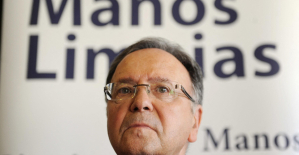The INE has reduced the 0.2% economic growth rate in Spain's first quarter, which it had calculated two months ago, to a new jug of chilled water. The omrome variant had a devastating effect on Spain's economy, making it more difficult than expected. Furthermore, the conflict in Ukraine at February's end only made matters worse. So, the volume of GDP is still 3.6% lower than it was in 2019, prior to the pandemic.
After growing by 2.2% in last quarter, the collapse in family consumption (no lower than -2% between January and March) has caused it not to register a negative rate for a year. This was despite the savings made in the pandemic.
The GDP grew 6.3% annually instead of 6.4% as predicted in the first estimate by the INE. This is a significant improvement when compared to the first quarter last year, which was still severely affected by the effects of the pandemic. Despite this, the INE notes that the foreign sector contributed 2.3% to the GDP for the first quarter. This is five tenths more than the previous quarter and the highest in nine years.
The main problem is the rise in prices. This affects essential goods like electricity and food, and decreases households' spending power in the rest. It also affects households with lower incomes more, says Santiago Martinez Morando from Ibercaja's Economic and Financial Analysis.
He acknowledged that the shock came with the economy "benefiting by the reactivation in the most affected sectors, and with the accounts households and companies very health in aggregate terms -although there are significant divergences between sectors and income levels-."
The most striking thing about the INE data is the low evolution in family consumption compared with the high performance of employment. Although the employment levels before covid were exceeded, there are still 8% to reach 2019's level of consumption.
The GDP grew only 0.2% in its first quarter. However, the employment measure of hours worked rose by 3.2% during the same period. The Government has voiced concern that the INE may be misleadingly measuring the economic evolution because these employment data are not included in the GDP.
The increase in investment in machinery, capital goods (9.1%), and housing (0.4%) accelerated the quarterly rise to 3.4%. This is the highest quarterly growth since the third quarter 2020.
At a quarterly level, the foreign sector saw exports slow to 1.1% compared to 7.2% in the previous quarter, while imports dropped by 0.8% for the first time since confinement.
The expert says that fiscal policy is still expansionary. "It's more likely that there will be greater laxity in the next months than a withdrawal from stimuli." This means that monetary policy won't be as favorable than in the past years, even though interest rates are still low in historical contexts and negative in real terms.
According to the analyst, the most likely scenario for next quarters is that of an "economic recovery" even though it's less than was expected prior to the conflict in Ukraine which exacerbated inflationary pressures. However, one must remember that there are many risks due to the conflict and volatility in raw material prices. This could lead to a delay in consumption or investment decisions. "This pessimism will become a self-fulfilling prophecy."

 Hamas-Israel war: US begins construction of pier in Gaza
Hamas-Israel war: US begins construction of pier in Gaza Israel prepares to attack Rafah
Israel prepares to attack Rafah Indifference in European capitals, after Emmanuel Macron's speech at the Sorbonne
Indifference in European capitals, after Emmanuel Macron's speech at the Sorbonne Spain: what is Manos Limpias, the pseudo-union which denounced the wife of Pedro Sánchez?
Spain: what is Manos Limpias, the pseudo-union which denounced the wife of Pedro Sánchez? Spain is the country in the European Union with the most overqualified workers for their jobs
Spain is the country in the European Union with the most overqualified workers for their jobs Parvovirus alert, the “fifth disease” of children which has already caused the death of five babies in 2024
Parvovirus alert, the “fifth disease” of children which has already caused the death of five babies in 2024 Colorectal cancer: what to watch out for in those under 50
Colorectal cancer: what to watch out for in those under 50 H5N1 virus: traces detected in pasteurized milk in the United States
H5N1 virus: traces detected in pasteurized milk in the United States Private clinics announce a strike with “total suspension” of their activities, including emergencies, from June 3 to 5
Private clinics announce a strike with “total suspension” of their activities, including emergencies, from June 3 to 5 The Lagardère group wants to accentuate “synergies” with Vivendi, its new owner
The Lagardère group wants to accentuate “synergies” with Vivendi, its new owner The iconic tennis video game “Top Spin” returns after 13 years of absence
The iconic tennis video game “Top Spin” returns after 13 years of absence Three Stellantis automobile factories shut down due to supplier strike
Three Stellantis automobile factories shut down due to supplier strike A pre-Roman necropolis discovered in Italy during archaeological excavations
A pre-Roman necropolis discovered in Italy during archaeological excavations Searches in Guadeloupe for an investigation into the memorial dedicated to the history of slavery
Searches in Guadeloupe for an investigation into the memorial dedicated to the history of slavery Aya Nakamura in Olympic form a few hours before the Flames ceremony
Aya Nakamura in Olympic form a few hours before the Flames ceremony Psychiatrist Raphaël Gaillard elected to the French Academy
Psychiatrist Raphaël Gaillard elected to the French Academy Skoda Kodiaq 2024: a 'beast' plug-in hybrid SUV
Skoda Kodiaq 2024: a 'beast' plug-in hybrid SUV Tesla launches a new Model Y with 600 km of autonomy at a "more accessible price"
Tesla launches a new Model Y with 600 km of autonomy at a "more accessible price" The 10 best-selling cars in March 2024 in Spain: sales fall due to Easter
The 10 best-selling cars in March 2024 in Spain: sales fall due to Easter A private jet company buys more than 100 flying cars
A private jet company buys more than 100 flying cars This is how housing prices have changed in Spain in the last decade
This is how housing prices have changed in Spain in the last decade The home mortgage firm drops 10% in January and interest soars to 3.46%
The home mortgage firm drops 10% in January and interest soars to 3.46% The jewel of the Rocío de Nagüeles urbanization: a dream villa in Marbella
The jewel of the Rocío de Nagüeles urbanization: a dream villa in Marbella Rental prices grow by 7.3% in February: where does it go up and where does it go down?
Rental prices grow by 7.3% in February: where does it go up and where does it go down? “Deadly Europe”, “economic decline”, immigration… What to remember from Emmanuel Macron’s speech at the Sorbonne
“Deadly Europe”, “economic decline”, immigration… What to remember from Emmanuel Macron’s speech at the Sorbonne Sale of Biogaran: The Republicans write to Emmanuel Macron
Sale of Biogaran: The Republicans write to Emmanuel Macron Europeans: “All those who claim that we don’t need Europe are liars”, criticizes Bayrou
Europeans: “All those who claim that we don’t need Europe are liars”, criticizes Bayrou With the promise of a “real burst of authority”, Gabriel Attal provokes the ire of the opposition
With the promise of a “real burst of authority”, Gabriel Attal provokes the ire of the opposition These French cities that will boycott the World Cup in Qatar
These French cities that will boycott the World Cup in Qatar Judo: Blandine Pont European vice-champion
Judo: Blandine Pont European vice-champion Swimming: World Anti-Doping Agency appoints independent prosecutor in Chinese doping case
Swimming: World Anti-Doping Agency appoints independent prosecutor in Chinese doping case Water polo: everything you need to know about this sport
Water polo: everything you need to know about this sport Judo: Cédric Revol on the 3rd step of the European podium
Judo: Cédric Revol on the 3rd step of the European podium


















